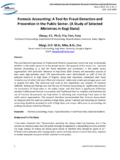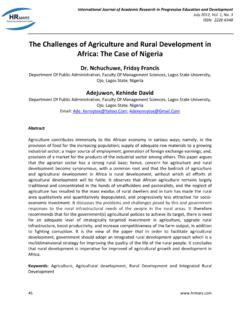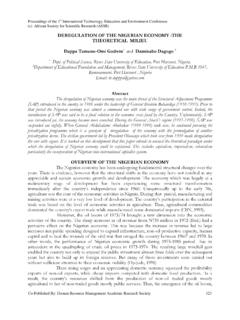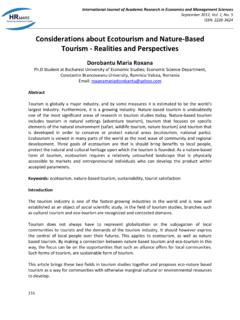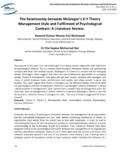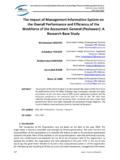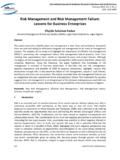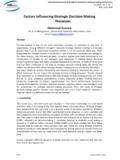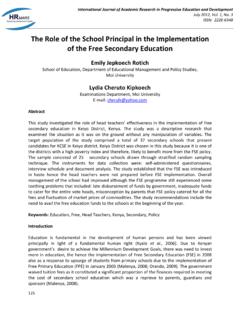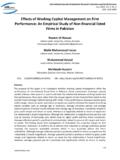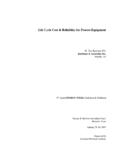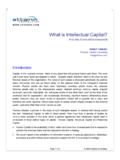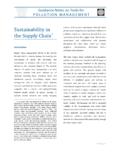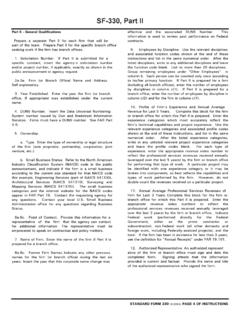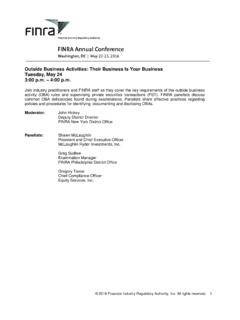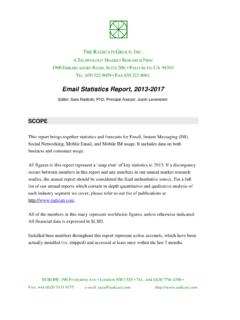Transcription of The Optimal Relationship of Cash Conversion Cycle …
1 International Journal of Academic Research in Business and Social Sciences April 2012, Vol. 2, No. 4 ISSN: 2222-6990 189 The Optimal Relationship of Cash Conversion Cycle with Firm Size and Profitability Muneeb Ahmad Attari MS Finance, A little Mubalig of Great Movement of Quran and Sunnat , Faisalabad, Pakistan Email: Kashif Raza Riphah School of leadership, Riphah international university Islamabad Pakistan Email: Abstract Cash Conversion Cycle (CCC) has been considered a useful measure of firm s effective working capital management and especially the cash management. This study was conducted with the aim to look into the association of the cash Conversion Cycle with the size and profitability of the firms in the four specific manufacturing sectors listed at Karachi Stock Exchange namely Automobile and Parts, Cement, Chemical, and Food Producers. The data was collected from the annual reports of 31 sampled firms out of the total firms in the related sectors 143 covering the period of 2006-2010.
2 The data analysis was conducted by using One-Way ANOVA and Pearson correlation techniques. The lowest mean value of the CCC length is found in the cement industry, with an average of days, and the highest mean value of the CCC is found in the Automobiles industry, with an average of days. As was expected there was found a significant negative correlation between the CCC and the firm size in terms of total assets, and was found a negative correlation between CCC and profitability in terms of return on total assets with the values of and respectively. This study presents an update account of the investigation into the subject matter of cash management- an area which is not very much researched upon in the developing nations like Pakistan. Within the particular context of the liquidity management it is supposed to be valuable for setting up ideal threshold points in the related sectors.
3 Despite having limited base for data analysis, the present study has a number of useful implications and is supposed to be insightful for the finance managers, industry planners, academics and researchers. Key words: - Cash Management, liquidity, Profitability, Cash Conversion Cycle (CCC), ANOVA, Pearson Correlation. International Journal of Academic Research in Business and Social Sciences April 2012, Vol. 2, No. 4 ISSN: 2222-6990 190 1. Introduction Background Finance is considered the lifeblood of business. Effective financial management is vital for the business survival and ultimate growth. As such almost all the decision regarding the cash management are considered much important as they relate to a much scarce and the most valuable resource of the business world. Almost all the decisions on the part of the finance managers pertaining to this valuable resource have much bearing upon the performance, risk and the market value of the firms.
4 The financial management decisions of companies are basically concerned with three major areas: capital structure, capital budgeting, and working capital management. Among these major areas, the working capital management (WCM) is an area of great significance for every company as it virtually affects its overall profitability and liquidity (Appuhami, 2008). For many of the companies engaged in the production of goods, the current assets usually in the form of the cash, cash equivalents and the inventories make up almost half of the sum of the asset side of the balance sheet, whereas this proportion may be much higher in the case of companies engaged in the business of distribution. The excessive amount of investment in these assets may result in the blockade of the company s precious cash resources and may eventually result in a decline of the return on the overall capital of the business.
5 Therefore, the areas of WCM basically cover the planning and controlling activities of the companies regarding their current assets and current liabilities in a manner that guarantees their ability to meet their current obligations satisfactorily as well as a maximum return on their precious investment in these floating assets. (Eljelly,2004). So the managers invariably have to devote a considerable amount of time and attention towards day to day and routine decisions regarding their current assets and liabilities due to their ever changing forms and nature in the business (Rao, 1989). Since the firm s liquidity is very much dependant on the quantum and quality of the cash flows generated by its current assets, the WCM is considered a vital part of its managerial finance decisions about the volume, composition and financing of these strategic assets? Funds represented by the current assets are a form of hidden cash or reserves that, if managed efficiently, can be utilized to finance the current and future expansion of the business.
6 The cash used to finance the accounts receivable and inventories should be freed as soon as possible and in amount as much as possible, so that the available cash can be invested in other more profitable avenues and thereby gain and hold a competitive edge over other players in the industry. Since the decisions regarding the efficient WCM demands more time and managerial attention in the highly stressing business routines, expert finance managers have always serious concerns about finding the most efficient ways of handling the current assets and liabilities. Cash Conversion Cycle CCC length is considered among the fundamental ingredients of the working capital management (Appuhami, 2008; Keown et al., 2003; and Bodie and Merton, 2000). It is invariably useful as a comprehensive measure because it effectively takes into account the time lag between the expenditure for the acquisition or purchases of raw materials and the collections from the debtors on account of the of sales of finished goods (Padachi, 2006).
7 It has been argued that an effective and efficient handling of short term assets and the International Journal of Academic Research in Business and Social Sciences April 2012, Vol. 2, No. 4 ISSN: 2222-6990 191 corresponding payables is really a question of life and death for the business enterprises and has much to do with the continued existence of the firms. (Jose et al.,1996). Definition Besley and Brigham (2005) describe cash Conversion Cycle as the length of time from the payment for the purchase of raw materials to manufacture a product until the collection of account receivable associated with the sale of the product. To account for the efficiency of the firm s cash management, the practitioners and researchers use the cash Conversion Cycle (CCC) parameter by considering the variables of inventory turnover, debtors turnover and the payables turnover. The CCC days are calculated by taking into account the 1.
8 Debtors turnover period, 2. Payables turnover period, and 3. Inventory turnover period. The CCC length in days can be simply calculated as follows: CCC days = inventory turnover days + debtors turnover days payables turnover days The major ingredients of the CCC turnover can be easily illustrated with the help of the following illustrated figure: Figure 1: The cash Conversion Cycle Adapted from Jordan (2003) As such it is self evident from the above equation and figure that in order to meet the fundamental objective of the effective and efficient cash management, handling both the receivables side and the payable side is very crucial and must be taken care of. The CCC can be positive or negative. A positive CCC indicates the number of days the management of the business International Journal of Academic Research in Business and Social Sciences April 2012, Vol.
9 2, No. 4 ISSN: 2222-6990 192 must arrange/borrow funds or resort to its available liquid assets before it gets the collections from its accounts receivables(s). on the other hand a negative CCC can be regarded as highly beneficial implying that firm has already received cash from its debtors by the number of days before it has to discharge its current obligations towards its creditors (Hutchison et al., 2007; Uyar, 2009). It thus follows that for the efficient financial management, the firms must try to make or keep the CCC days as minimum or preferably in negative as it can ultimately relieve the firm owners/managers from many worries of cash bottlenecks and liquidity problems. There is always placed a heavy responsibility on the part of finance managers and decision makers if the CCC has to be kept at its minimum, or possibly at a negative level. In this regard the firm may opt any one or a combination of the working capital management strategies as follows (Bodie and Merton, 2000; Uyar, 2009): Curtailing the firm s stock turnover days: In order to keep the stock turnover days as minimum as possible, the managers must ensure an effective and efficient inventory system for order placement, material handling, material requisition and issuing, and the regular stock checking and reporting.
10 The efficient inventory management methods and approaches like Just In Time (JIT) approach, or the Quick Response Supply (QRS) can be commissioned for an effective system for ensuring most economical ordering and stock handling costs. Quick collections from trade debtors: If a firm has to ensure a strong and long term liquidity and solvency position business owners/managers must ensure an efficient and speedy procedure of collection of its accounts so that there occur no liquidity problems in the business. Delaying the payment of current obligations, utility bills etc. It has always been advisable to get as much delay, or relaxation in the payment of payment of the current obligations in such a way that it is able to avail as much days from its suppliers and creditors as possible before such obligations are actually paid out. According to Padachi, (2006), firm s ability to realize the cash receipts from accounts receivables in advance and in excess of the cash disbursements is invariably a successful strategy for business survival and growth.
